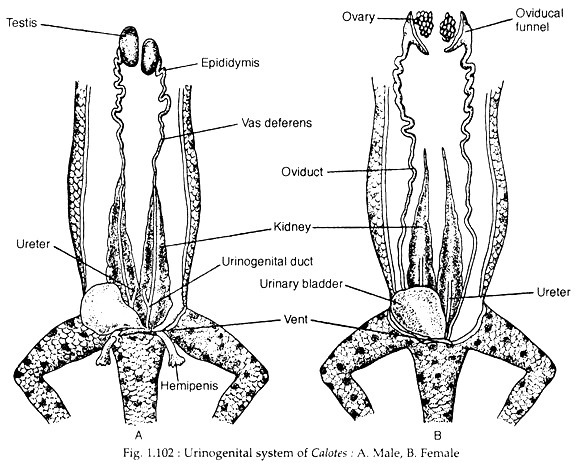In this article we will discuss about the male and female reproductive system of calotes.
Male Reproductive System:
This system includes a pair of testes situated in the abdominal cavity which remain suspended by a special dorsal fold of the mesentery called mesorchium. The testes are white oval bodies. The testis of the right side is larger in size compared to that of the left side and situated slightly higher up in the abdominal cavity.
The testes undergo a drastic change in size. During the breeding time they become larger than the non-breeding period. From the inner surface of each testis runs the epididymis which receives the vasa efferentia. The epididymis proceeds posteriorly as vas deferens (Fig. 1.102A).
Two vasa deferentia open separately by small papillae into the cloaca but before opening into the cloaca each receive the ureter of the corresponding side. So, through this common duct, both urine and male gametes pass into the cloaca which is designated as the urinogenital duct.
ADVERTISEMENTS:
The posterolateral side of the cloaca is provided with a pair of copulatory sacs each of which houses a hemipenis. The hemipenis is eversible.
The hemipenes (plural of hemipenis) are actually the bilateral sacculations of the cloaca which extend posteriorly below the skin. When everted, the hemipenes protrude through the cloacal aperture. The distal end of each hemipenis is large and rounded. The hemipenes are grooved to conduct sperms from the cloacal cavity of the male into that of a female.
Female Reproductive System:
ADVERTISEMENTS:
This system includes a pair of ovaries which have similar position as that of testes (Fig. 1.102B). Each ovary is fixed to the dorsal side by a special fold of mesentery called mesovarium. The female gonoduct is called oviduct. The oviduct is attached with the body wall by a special fold of peritoneum called broad ligament.
The anterior end of the oviduct is wide, funnel-shaped, ciliated and is situated near the corresponding ovary below the level of lungs. The oviducts are not coiled but are folded which run posteriorly to open independently into the cloaca. The diameter of the oviduct shows gradual increase towards the posterior side in cross section.
The lower part of the oviduct is designated as the uterus where the eggs are stored temporarily prior to laying. In the anterior part of the oviduct there are many albumen glands and the posterior part is provided with shell glands. In Calotes, fertilisation is internal. Mature eggs are fertilised in the anterior part of the oviduct. The eggs are heavily yolked and are covered by calcareous shell.
